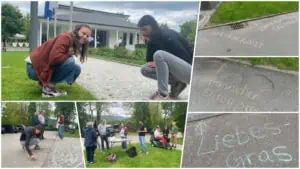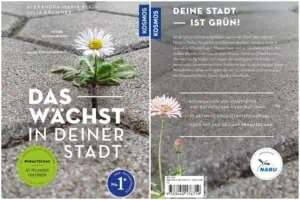At the herb show in mid-May at the Freiburger Golf Club, the many fascinating, small plant species between pavement joints and cracks in walls came into their own.
Have you ever heard of urban biodiversity, and can you connect it to a golf course? With the #Krautschau campaign in mid-May at the Freiburger Golf Club, Alexandra-Maria Klein, an ecologist who heads the Chair of Nature Conservation and Regional Ecology at the University of Freiburg, and her doctoral student Anna Klopstock drew attention to the more than 500 different plant species between the paving joints and cracks in the walls of the golf course. Especially in the area of the clubhouse, range and parking lot, club members and guests were whisked away to the hidden diversity of the small, fine plant world on the open day.
Equipped with colourful children’s chalk and the Flora Incognita app on their cell phones, countless small plants were photographed, digitally identified and named legibly (analogue) on paving stones and asphalt so that over the course of the sunny early summer day, many golfers “stumbled” across field speedwell, shepherd’s purse, panicle grass, daisy, Persian speedwell, hollow tooth, bird’s knotweed, cranesbill, love-grass, common ragwort, daisy or narrow-leaved ragwort.
Little survivors
“The Krautschau was created together with Julia Krohmer from Senckenberg and the Krautschau is all about looking at the small things. The plants that are in the cracks, so to speak,” says Anna Klopstock, who, together with her colleague from the university, cycled the few minutes along the Dreisam to Kirchzarten to the golf club. “We are doing this on the golf course as part of the Germany-wide Golf Biodivers project run by the universities of Freiburg, Münster, Kiel and TU Munich. We enhance golf courses to promote biodiversity. This means that we first record the current state of the course – in terms of flora and fauna – then we implement certain enhancement measures, such as flower strips, and then we measure the effects of these enhancement measures.” Animals and plants are examined: Insects, butterflies, grasshoppers and the like have already been recorded at Freiburger Golf Club. “Today, however, the herbaceous plants are to be monitored. If you squat down really low here, you can see fascinating little survival artists squeezing their way through. So take a look at the little things.”
Why is this important? Even where asphalted roads are the order of the day, hardy greenery is always looking for its place: mosses, herbs, grasses and flowers spread out in crevices and road joints, between paving stones and in cracks in walls, where they bind dust and water and provide a habitat for a wide variety of microorganisms.
Here’s how you can take part: Use the code KRA VT5 HAV to unlock the “Krautschau” project in the Flora-Incognita app! It’s very simple and, of course, free of charge. Find and identify plants on your doorstep or on your golf course, and confirm your findings by clicking on the green tick in the top right-hand corner. Then, assign the observation to the “Herbaceous Show” project.
Book tip: What’s growing in your city
Alexandra-Maria klein and Julia Krohmer have sorted the plants according to a specific system so that you can find them as quickly as possible in a practical and extremely appealing book. 95 species are grouped according to their growth habit. To help you quickly find out which group you are currently in, there are corresponding symbols at the bottom of each page. The A5 book recommended by NABU comprises 140 pages and was published by Kosmos Verlag in 2023 (price: 14 euros).








